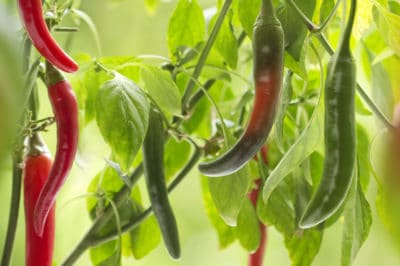Planting
In USDA hardiness zones 11 and above, which are subtropical and tropical regions, chili peppers are perennial plants. In these regions, seed can be directly sown outdoors at any time of the year in a sunny location. Pepper plants require well-draining soil that is rich in organic matter.
In cooler climates, cayenne peppers can be grown as annuals with worthwhile success. Start them indoors in a climate controlled room 8-12 weeks before the last frost date in your region. Ideal germination temperature is above 65-70°F (18-21°C) so adding a heater to the germination room is helpful when starting cayenne peppers in cold climates.
When there is absolutely no danger of frost or the soil temperature has warmed to above 55°F (12°C) cayenne pepper starts can be transplanted outside. Do not transplant them without first acclimating them. In USDA zones 7 and below, cayenne peppers may need to remain in a greenhouse or polytunnel through the season for the best results.
Pepper Plant Care
Each plant in the garden requires water, sunlight, and nutrients to grow. The key to effortless gardening is learning each plants preference and finding a low-labor way to provide it. Here is a guide to caring for cayenne peppers.
- Soil: Well-draining and amended with lots of rich compost. Perlite helps to retain water and aids drainage.
- Watering: Keep the soil moist at all times, avoid over-watering by adjusting for precipitation and sticking to a schedule.
- Nutrients: While peppers can be heavy feeders, they are also prone to suffer from over-fertilization. Amend the soil with compost and only apply organic liquid fertilizer or compost tea if plants show signs of slow growth or deficiency.
Troubleshooting
While most pests will steer clear of the capsicum in the cayenne pepper fruit, the foliage is often a target. Spraying the leaves with a compost tea or Epsom salt solution will strengthen them and help to fight off pests. Plant cayenne near aromatic companions like garlic, herbs, and onions to detur plant-eating bugs and attract predatory insects.
Fungus will attack pepper plants if given the chance. Trim lower branches to allow good airflow near the soil. use drip irrigation to avoid soaking the soil surface around the plant.
Cayenne peppers can be prone to calcium deficiency which is also often attributed to the over-use of soluble nitrogen fertilizers. Grow them organically for the best results.
